Fettuccine pasta ribbons.
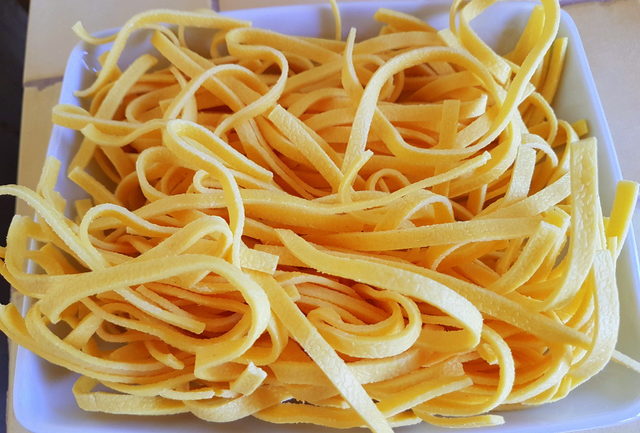
When we think about flat egg pasta ribbons two types normally come to mind; fettuccine and tagliatelle. Both are normally an egg pasta, produced using a mixture of durum wheat flour and eggs. Both types of pasta ribbons are typical and traditional in the central and northern regions of the Italian peninsula. However, their popularity has spread to other regions and there are many different recipes for both cooked throughout Italy. In Southern Italy, pasta ribbons are more likely to be made without egg.
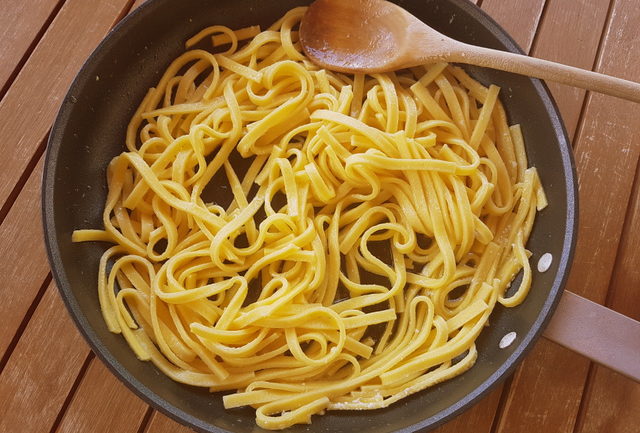
The difference is in the width of the noodle.
Both fettuccine and tagliatelle are traditionally made fresh with more or less the same ratio of eggs to flour (1:100g per person) and are made by rolling the dough out into a thin sheet which is then rolled up and cut. It is really only the width of the pasta that makes the difference. Here in Italy, it’s possible to buy fresh fettuccine in almost any supermarket. Many pasta makers also produce a dried version, but making your own pasta ribbons is also a very satisfying and delicious endeavour.
Fettuccine are usually thinner than tagliatelle; normally 3-5 mm in width. Tagliatelle are wider, 6-10mm. If you cut the pasta strips wider still then you have pappardelle! If you cut the dough to 1 or 2 millimetres wide then it’s tagliolini! However, be warned, not all Italians agree on these measurements and you may come across other variations, especially from one region to another.
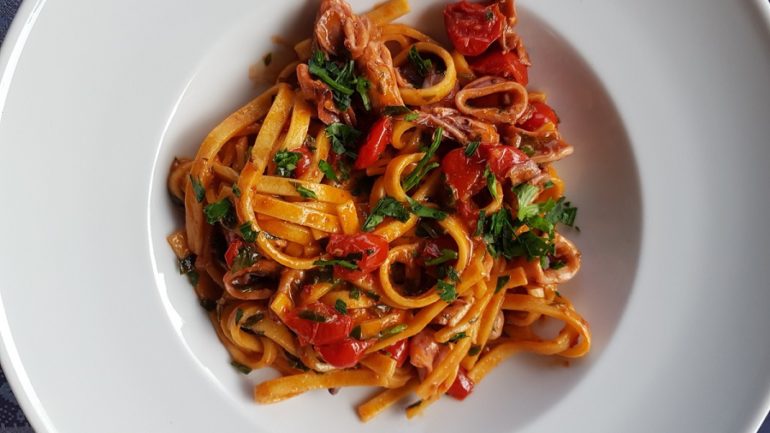
Like many fresh egg flat pasta, fettuccine is thought to be a descendant of the Roman and Greek pasta known as ‘lagane’. Most well-known and traditional Italian recipes for this pasta include 'alla paplina’ from Rome, a dish invented at the request of Pope Pius XII and very similar to carbonara, and 'alla ciociara', made with meat ragu, prosciutto, mushrooms and peas. Ciociara is a region in the province of Frosinone, Lazio, famous for its thin ribbon pasta which is also often served with porcini mushrooms or in a more modern recipe with ‘pomodori bruciati’, burnt tomatoes!
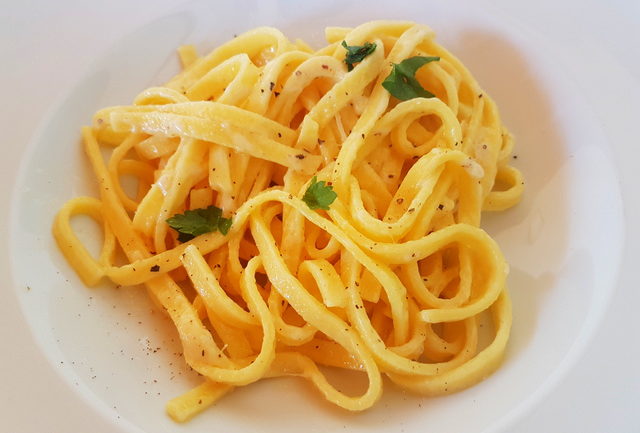
You might have expected me to include Alfredo in the above list but actually, although it’s one of the most popular dishes for fettuccine in USA, Alfredo sauce as eaten in US is rarely eaten in Italy. The Italian-American version of Alfredo usually consists of mostly cream and Parmesan cheese. In Italy, however, cream is not used that often to make pasta sauces. Americans call it ‘Alfredo’, after Alfredo di Lelio who invented it in his restaurant in Rome at the beginning of 20th century. However, in Italy it is mostly just called ‘pasta al burro or doppio burro’ which means pasta with butter. Alfredo's original recipe also included only Parmesan and butter! It’s only because of its popularity with tourists that you will find fettuccine all'Alfredo on restaurant menus in Rome and in order to eat the original recipe it's best to go to the restaurant which is still run by Alfredo de Lelio's grandchildren 'il vero Alfredo'.
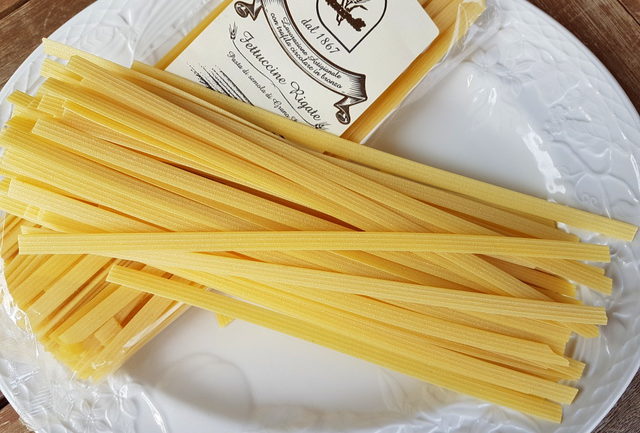
Speaking of Americans and fettuccine, I recently came across a dry fettuccine I had never seen before! These were fettuccine rigate (ridged) and I found them made by an artisan pasta maker in Abruzzo called Masciarelli. At first, I thought this pasta must be typical of Abruzzo and not so common in other regions. But, after having done some research it seems that fettuccine rigate are, in fact, an American innovation. Barilla also makes them, but apart from Barilla, Masciarelli and another producer in Abruzzo called Mamma Regina, I couldn’t find any other Italian producers.
If you get the chance to try fettuccine rigate, do so. I used it in a dish from Abruzzo for pasta with saffron and zucchini and the result was excellent! You might also like to try my hubby's recipe for fresh fettuccine with calamari. He loves using this pasta in seafood recipes and I can understand why. It's always delicious.
[amazon_link asins='B003OW7JN2,B0725M8262,1623159180,B00B0XADJ4,B00M9D3L2U,B01MDRM5Y7' template='ProductCarousel' store='thepastaproje-21' marketplace='UK' link_id='8e0f580a-8682-11e7-bdaf-35bc889362b3']
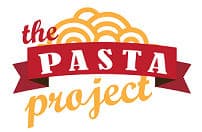

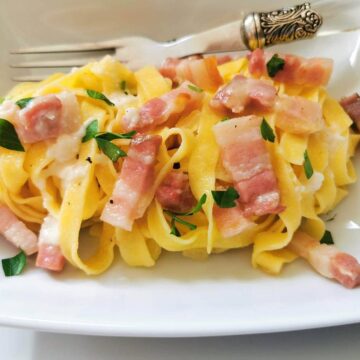
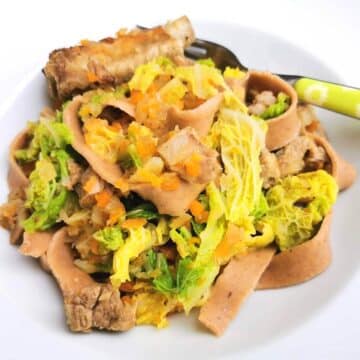
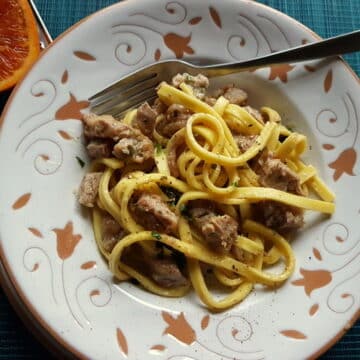
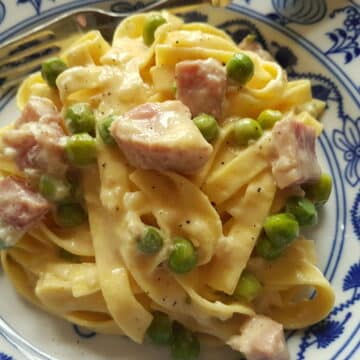
COOKING PIANIST says
Dear Pasta Project
I have read your atricle with interest, and much compliments to your website. Nonetheless I have done researched myself too on the subject about the difference between Tagliatelle and Fettucine, and it is exactly opposite of what you are describing in your article: Tagliatelle is less in width (5 mm) and Fettucine are wider (7 mm). We have Tagliatelle that are wider than Fettucine, called Taglietelle Larghe (9 mm). This was confirmed as well in 2 Italian cooking books of mine and also on the Site of Barilla. I also asked an Italian friend, who confirmed me this. Anyhow, I thought just wanted to mention this to you.
admin says
Dear Cooking Pianist, thank you for your comment. Before writing this article I did a lot of research on the difference between fettuccine and tagliatelle. It seems that there are many different opinions throughout Italy and there's no exact rule. However, according to Wikipedia and the Accademia Italiana della Cucina and other sites I have seen tagliatelle is often described as being 7-8mm wide and therefore wider than fettuccine. Here's the link to Wikipedia https://it.wikipedia.org/wiki/Tagliatelle. So, in the end that was the opinon I decided to go with. I'm happy you like my site and appreciate your feedback immensely.
Ines Di Lelio says
With reference your article I inform you my grandfather Alfredo Di Lelio, creator of fettuccine Alfredo opened in 1914 in Rome his restaurant, which in 1943 sold to others outside his family. In 1950 Alfredo reopened Il Vero Alfredo (Alfredo di Roma) in Rome, which is now managed by me with the “gold cutlery” donated in 1927 by American actors M. Pickford and D. Fairbanks. Other restaurants "Alfredo" in Rome are out of my brand. See the website (also for franchising news). Ines Di Lelio
admin says
Dear Ms Di Lelio, thank you for your comment. I knew that the original recipe for Fettuccine Alfredo was invented by Alfredo di Lelio in Rome, but this article is about fettuccine in general and I didn't plan to write much about the history of Alfredo sauce, except to say that the recipe that is popular in USA isn't the original Italian recipe, which is more commonly referred to in Italian homes as 'al burro'. However, I have added a little more about the recipes origins to this article and mentioned your restaurant. If you like, I can also add a link to your restaurant website. Let me know. All the best from Verona.